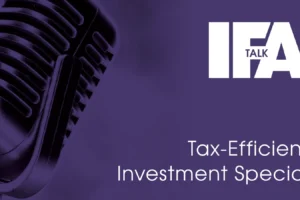In a recent webinar hosted by IFA Magazine, Senior Financial Journalist Jenny Hunter and Editor Sue Whitbread, welcomed fund managers Francis Chua and James Giblin from LGIM to explore the evolution, application, and strategic considerations of factor investing.
Factor investing has undergone significant evolution since its inception, and understanding its development and application is crucial for UK financial advisers aiming to optimise client portfolios. This discussion provided valuable insights into how factor investing has become increasingly sophisticated, offering practical tools for advisers to enhance investment strategies.
It’s all about the evolution
Factor investing, as defined by Francis Chua and James Giblin, refers to focusing on specific characteristics or “factors” that explain an investment’s risk and return within a diversified portfolio. This strategy aims to achieve higher returns or manage risk more effectively by leveraging these factors. Francis and James traced the origins of factor investing back to the 1960s, initially focusing on market risk premia. The approach expanded significantly with the introduction of size and value factors by Fama and French in 1992.
James highlighted the growing complexity in factor investing, noting that “a study has identified 600 different factors, often referred to as a ‘zoo of factors.’” He emphasised that portfolio managers must sift through these factors to determine which are valuable for inclusion in portfolios. This process involves evaluating factors based on evidence of their persistence across different economic conditions and regions, academic validation, and understanding the rationale behind each factor.
Francis elaborated on key equity factors commonly used in portfolios: value, low volatility, quality, size, and momentum. He explained that the persistence of these factors is supported by extensive long-term data and academic research. Francis stressed the importance of understanding why these factors exist, citing reasons such as risk, structural market elements, and behavioural biases.
James also provided insights into behavioural aspects, such as confirmation bias and herding, which can lead to irrational investment decisions. He referenced renowned investors like Warren Buffett and Benjamin Graham, highlighting their successful use of value investing. Studies showing the long-term outperformance of value stocks underscore the practical benefits of these factors.
Factor investing in action
James Giblin from LGIM emphasised the importance of asset allocation in driving portfolio returns, stating, “We believe asset allocation is key to return driving, but fund selection also adds value.” LGIM’s approach is marked by a robust, dedicated research team that includes sector-specific analysts and a comprehensive structure catering to both public and private markets. This structure supports institutional and retail clients alike. James explained that LGIM employs a rigorous selection process for fund managers, focusing on areas with market inefficiencies and managers who demonstrate a sustainable competitive advantage. “All our active equity managers must exhibit at least one of five key factors,” he noted.
Francis Chua provided insights into the ongoing debate between active and passive investing. He stated, “We are agnostic but take an open approach. Blending active and passive strategies allows us to utilise the strengths of both.” Francis elaborated that around 35% to 40% of LGIM’s portfolios are allocated to active managers, especially in asset classes where passive options are limited. He emphasised the role of active managers in navigating risks and leveraging factors effectively.
When discussing the sustainability of competitive advantages in fund managers, Francis remarked, “The key word here is sustainable. We seek evidence that managers stay true to their stated factor exposure across different market cycles.” He further explained that LGIM evaluates managers using various tools to ensure consistent factor exposure and performance against relevant benchmarks.
Addressing the performance of factor investing, James shared compelling data illustrating the long-term success of this approach. “Factor-based investing has been very successful over the long run. For instance, investing in value since 1963 would have yielded nearly £200,000 from an initial £100 investment,” he stated. James highlighted that while short-term results can be mixed, different factors perform better under varying market conditions, underscoring the importance of patience and perspective.
This section concluded with a discussion on the practical application of factor investing, blending multiple factors, and selecting the right managers. Francis used an analogy, “Understanding the ingredients each manager brings helps us blend them together effectively.” James added, “We look for managers with narrow mandates who excel in specific market areas,” emphasising the importance of selecting managers who can offer specialised expertise.
What’s in LGIM’s portfolio right now?
James explained LGIM’s rigorous approach to fund research, stating, “At LGIM, we believe asset allocation is crucial to driving returns, but fund selection also plays a key role.” He highlighted LGIM’s distinctive structure, which includes dedicated teams for both public and private markets, providing a comprehensive, institutional-level analysis for all client types. James described LGIM’s selection process: “We look for managers in inefficient markets, requiring them to demonstrate a sustainable competitive advantage and adhere to key factors like value or quality.” This thorough process ensures that only the most promising managers are included in their portfolios.
Francis shared insights into LGIM’s balanced use of active and passive strategies. “We’re agnostic about whether to use active or passive management; it depends on the specific needs of the portfolio,” he noted. Francis explained that LGIM blends both approaches, with around 35-40% of their portfolio allocated to active managers, particularly in asset classes where passive options are less effective. “Active management allows us to navigate risks and exploit factors where passive options may not be available,” he added.
James also discussed the performance of factor investing, referencing historical data to illustrate its success. “Factor investing has shown compelling long-term success,” he said. For example, investing in value factors since 1963 would have nearly quadrupled returns compared to the market. James emphasised that while short-term results can vary, factors like quality and size often complement each other well, enhancing overall performance.
Conclusion
Factor investing has advanced considerably from its early days, evolving into a sophisticated approach that offers a structured way to understand and enhance investment performance. This strategy is not merely theoretical but is practical and data-driven, providing financial advisers with valuable tools for making informed decisions and potentially improving returns while managing risk.
Overall, factor investing offers a robust framework for strategic investment decisions, backed by historical data and research. By understanding and applying these factors, UK financial advisers can enhance portfolio performance and better align strategies with client objectives, achieving improved investment outcomes in today’s dynamic market environment.
To access the full insights, be sure to tune into the webinar recording here
Click here to learn more about LGIM
















